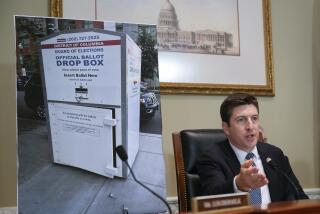It’s a long shot, but here’s how Colorado secession would work

- Share via
Back in 2009, when he was a candidate struggling for reelection, Texas Gov. Rick Perry swung by a tea party rally in Austin and famously winked at the idea of his state breaking off from the U.S. and creating a whole other country.
He quickly became the butt of jokes on the late-night TV circuit -- this was before his famous “oops” moment as a presidential candidate -- and Perry just as quickly backed off the notion.
Cynical? Perhaps. Calculated? So it seemed: The move boosted Perry’s tea party credibility and helped him on his way to a smashing reelection win en route to that ill-fated 2012 White House bid.
Now, with greater earnestness, activists are emulating that breakaway spirit, launching secession movements in several states, among them California, Michigan and Maryland. None, however, has gone as far as one in Colorado, where advocates have managed to put the question before voters in 11 rural counties this November.
Although most consider secession a long shot, there is a process that could bring the question to a statewide vote as soon as November 2014.
As Weld County Commissioner Sean Conway, a leading secession proponent, explained, the first step is an advisory vote in those 11 counties on Nov. 5.
If residents approve, local lawmakers would then proceed to the Capitol in Denver and lobby state legislators to bring the matter to the state ballot as a constitutional amendment.
That would require two-thirds approval by both houses. Failing that, Conway said, proponents could put the measure to statewide vote by collecting 80,000 petition signatures.
That may be the easy part, compared to what would come next. If Colorado voters agreed to cede those 11 counties, the matter would then go before Congress, which has to give its stamp of approval.
Four states have been carved from the territory of others: Kentucky, Maine, Vermont and West Virginia. But it’s been a while. West Virginia, the last state to break off from another, did so back in the Civil War, splitting from Confederate Virginia in 1863.
Follow Politics Now on Twitter and Facebook
Twitter: @markzbarabak
More to Read
Sign up for Essential California
The most important California stories and recommendations in your inbox every morning.
You may occasionally receive promotional content from the Los Angeles Times.













